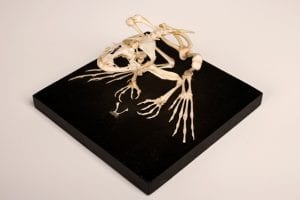Specimen of the Week 266: Frog skeleton
By Dean W Veall, on 18 November 2016
Hello all, Dean Veall here. This week I’m presenting a specimen of the week from a species that is a firm favourite of the UK wildlife scene and, as the Winter starts to creep upon us, one that we are likely to see less of as they remain dormant in nice warm compost heaps or amongst dead wood or leaves. My specimen of the week is the….
**Frog skeleton**
1). Anura
This specimen has been ‘helpfully’ identified as a mounted skeleton of a specimen belonging to the order Anura. ‘Helpfully’ with sarcastic quotes, because this specimen belongs to the order of amphibians that includes another 6,682 species and is the largest of the three groups of amphibians. The other two groups include the Caudata (salamanders) of which there are around 691 species, and Gymnophiona (caecilians) making up the other 251 species. The total number of amphibian species is around 7,579 and, astonishingly, since 1985 the number of recognised species has increased by over 60%.
Members of the Anura, or frogs if you will, are widely distributed across the world from tropics to the sub-arctic, with the greatest concentration of species diversity in the tropical regions of the planet. Who doesn’t love a frog? Lots of people as it turns out and culturally they’ve often been given short shrift – portrayed as malign, ugly and clumsy, however, in my opinion they are anything but.

Ranitomeya amazonica By V2, first published on his homepage youngester.com – Picasa – Ranitomeya amazonica, CC BY-SA 3.0, https://commons.wikimedia.org/w/index.php?curid=12754822
2). Frogs vs. Toads
“What is the difference between frogs and toads?” is a question that often gets raised when discussing this group. Well, despite popular belief, toads are actually frogs. The term toad is not a real taxonomic distinction that reflects a discrete grouping within the Anura, but is a discrimination based on morphology. A few of those distinctions between frogs and toads includes skin texture, ‘toads’ have drier warty skin, whilst ‘frogs’ have smooth moist skin and the hind legs, ‘toads’ have short stubby hind legs compared to the long legs of ‘frogs’. Another diagnostic feature that distinushes them is the presence of teeth, frogs have them and toads don’t (generally). When referring to frogs and toads people tend to generally picture individuals that belong to just two families out of 33, firstly the ‘true frogs’ (species belonging to the family Ranidae) and the ‘true toads’ (species belonging to the family Bufonidae – although some of these are called frogs…). Confused? That’s why taxonomy uses shared common ancestors to name groups, instead of features that might just be adaptations to a habitat these days.
3). Decline
Amphibians are in trouble, according to one study from the Macquarie University in Australia has suggested that some 200 species of frogs have gone extinct in the last century, with an estimated extinction rate 211 times higher than the ‘normal’ rate of extinctions scientists would expect for that group. Some scientists have even gone so far as to suggest we are actually witnessing a mass extinction of this group due to many man-made factors. What is troubling for scientists is the fact this mass extinction of the group is hard to explain, there have been many factors thought to be contributing to the decline, from habitat destruction, increased chemical pollutants and the effects of a deadly fungus called Batrachochytrium dendrobatidis. If any one group of animals should represent the current bio-diversity crisis, I strongly think it should be frogs, but the world would seemingly disagree, maybe because they’re not warm and cuddly.

Golden Toad (Bufo periglenes) that was declared extinct in 1989
Charles H. Smithvergrößert von Aglarech https://commons.wikimedia.org/w/index.php?curid=12479490
4). Mating behaviour
The reproductive behaviour of frogs is one we know very well and it’s a metamorphosis that is pretty awesome. What they don’t teach us in nursery is what happens before the egg is fertilised – and perhaps rightly so! Frogs display a mating behaviour known as amplexus where the male grasps the female with his front legs and holds on so he can fertilise her eggs as they are released from her body. During the mating season, some males get very carried away with the urge to reproduce and they mount small rocks or form mating balls, where one female is overwhelmed by a large number of males jostling for prime position and attempting to displace the competition. This frenzied behaviour often results in a high mortality rate among females.
Dean Veall is Learning and Access Officer at the Grant Museum of Zoology
 Close
Close



